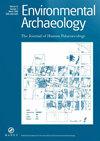Evaluating Non-destructive Analysis and Sampling Methods for Identifying Plant and Animal Imprints in Late Pre-contact Wattle and Daub Rubble from the Yazoo Basin, Mississippi
IF 1.1
3区 地球科学
0 ARCHAEOLOGY
引用次数: 0
Abstract
ABSTRACTPast analyses of burned wattle and daub rubble from Native American house excavations have shown that plant and animal-related imprints sometimes occur in daub fragments. This paper evaluates the use of non-destructive analysis and sampling methods from a region-wide assemblage of burned daub recovered from a group of Pre-Contact Mississippian Period village and settlement sites in the Yazoo Basin of northwestern Mississippi, U.S.A. The quality and occurrence of imprints from this assemblage will be assessed, and how they may be considered in both future paleoenvironmental research and curation practices.KEYWORDS: Mississippian periodwattle and daubpaleoenvironmental analysissampling methodsSoutheastern archaeologyYazoo Basin AcknowledgementsThis paper was made possible by the suggestions and work of Dr. Evan Peacock, who spearheaded much of the early research into daub. The author also wanted to thank John Connaway for his work excavating the bulk of these artefacts, and for his significant early contributions to this subject. Drs. Andrew Ezell and David Evans, both of Mississippi State University, were instrumental in helping to identify some of the arboreal species observed in the daub, and I am deeply grateful for their assistance. The author wants to also thank the institutions and repositories that allowed him to conduct this research using their collections.Disclosure StatementNo potential conflict of interest was reported by the author(s).DedicationThis paper is dedicated to the memory of Mary Evelyn Starr, who was a pioneer of this very subject, a tireless archaeologist and a true scholar of the Mississippi Delta.PermissionsThe author has full ownership of figures and data used in this paper.Additional informationNotes on contributorsWilliam D. HarrisWilliam D. Harris received a Master of Arts in Applied Anthropology from Mississippi State University in 2020 He specializes in Southeastern U.S. and Great Plains archaeology and studies seriation and artifact analysis methods.评估非破坏性分析和取样方法,鉴定密西西比州亚祖盆地晚期接触前的金合欢和涂抹碎石中的植物和动物印记
【摘要】过去对从美洲原住民房屋挖掘中发现的烧过的灌木和灌木碎石的分析表明,灌木碎片中有时会出现植物和动物相关的印记。本文评估了非破坏性分析和采样方法的使用,这些方法是从美国密西西比州西北部亚祖盆地一组接触前的密西西比时期村庄和聚落遗址中恢复的全区域烧伤涂抹物组合中获得的。该组合中印记的质量和出现情况将被评估,以及如何在未来的古环境研究和管理实践中加以考虑。关键词:密西西比周周炎与涂抹古环境分析采样方法东南考古亚祖盆地致谢埃文·皮科克博士的建议和工作使本文成为可能,他是早期涂抹研究的先驱。作者还想感谢John Connaway挖掘这些文物的工作,以及他对这一主题的重要早期贡献。Drs。密西西比州立大学的安德鲁·埃泽尔和大卫·埃文斯,在帮助鉴定在涂布中观察到的一些树栖物种方面发挥了重要作用,我对他们的帮助深表感谢。作者还想感谢那些允许他使用他们的藏品进行这项研究的机构和图书馆。披露声明作者未报告潜在的利益冲突。本文谨以此纪念玛丽·伊芙琳·斯塔尔,她是这一学科的先驱,是一位不知疲倦的考古学家和密西西比三角洲的真正学者。作者对本文中使用的图形和数据拥有完全所有权。william D. Harris于2020年获得密西西比州立大学应用人类学硕士学位,他专门研究美国东南部和大平原考古,研究序列和人工制品分析方法。
本文章由计算机程序翻译,如有差异,请以英文原文为准。
求助全文
约1分钟内获得全文
求助全文
来源期刊

Environmental Archaeology
GEOSCIENCES, MULTIDISCIPLINARY-
CiteScore
4.80
自引率
0.00%
发文量
32
期刊介绍:
Environmental Archaeology: The Journal of Human Palaeoecology aims to publish contributions on all aspects of environmental archaeology, from methodology to synthesis and theory.
Environmental Archaeology is an international peer-reviewed periodical which welcomes contributions that consider the interaction between humans and their environment in the archaeological and historical past. This broad scope embraces papers covering a range of environmental specialisms within archaeology, such as archaeobotany, archaeozoology (both vertebrate and invertebrate), palynology, geoarchaeology, biological anthropology, as well as more synthetic and theoretical approaches to the past human environment. Assemblage and site reports are not encouraged unless these can demonstrate significant new insights in environmental archaeology. Contributions may take the form of substantial research papers or shorter reports and may include, for instance, new techniques, philosophical discussions, current controversies and suggestions for new research. The journal also provides its readership with critical appraisal of recent academic scholarship through its regular books review section.
 求助内容:
求助内容: 应助结果提醒方式:
应助结果提醒方式:


